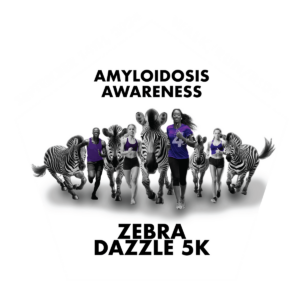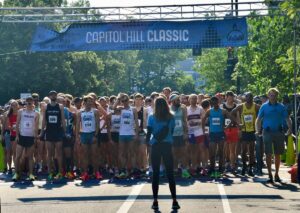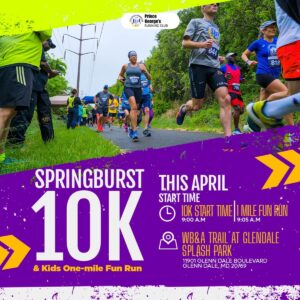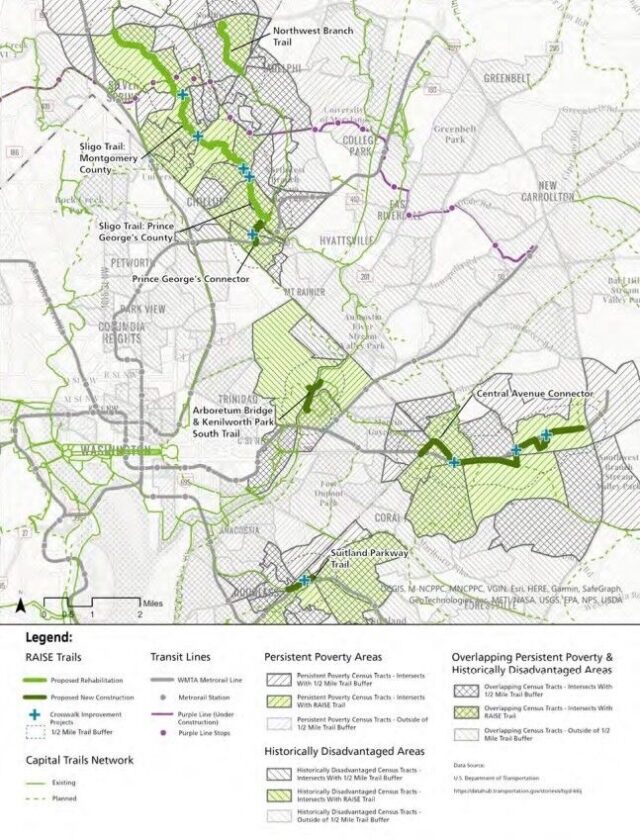
- A man broke an adult male runner’s nose while beating him after the runner bumped into him at approximately 11 a.m. June 24 on the Anacostia Riverwalk Trail near RFK Stadium in Northeast DC.
- A man grabbed and tried to abduct a teenaged girl who was running on Beach Drive near Meadowbrook Park in Chevy Chase at around 2:30 p.m. June 21, after she declined his offer of a ride.
- A $25 million RAISE grant from the Department of Transportation will fund rehabilitation of the Sligo Creek Trail and the Northwest Branch Trail, building the Suitland Parkway Trail and the Central Avenue Connector Trail in Central Prince George’s County, and help complete the Kenilworth Park South Trail and the bridge between Kenilworth Park and the National Arboretum.
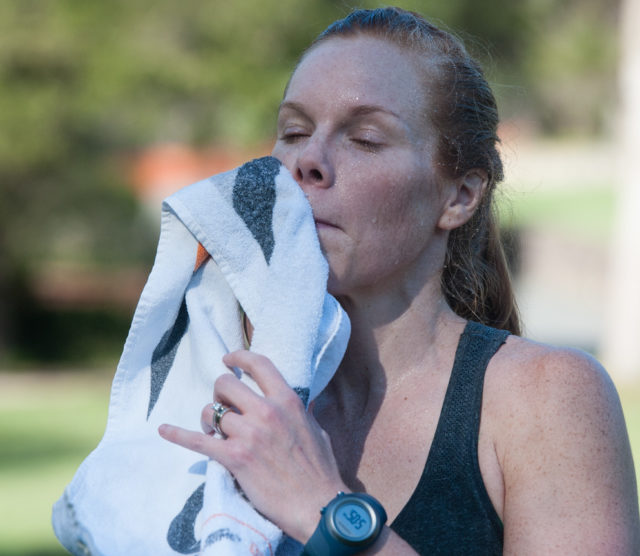
Editor’s note: This was originally published in 2016, but this seems like a good time to revisit it.
Summertime in DC: stepping out the front door is like stepping into a sauna. You don’t generally notice air, but today its presence is palpable and oppressive, a thick cloud that weighs on you and seems to stall your forward progress. Within seconds you’re sweating buckets, water pouring off you in all directions. What is this torture?
It’s not the heat; it’s the humidity.
“I hate it,” said Chelsea Cox, who lives in D.C. and competed in the 800 meters at the 2016 USA Track and Field Indoor Championships. “It’s just miserable to me, especially when the heat gets high.”
Humidity’s misery comes from its disruption of the body’s cooling system. “The basic mechanism by which we cool ourselves in the heat is by sweating,” said Dustin Slivka, an exercise physiologist at the University of Nebraska at Omaha. But, “Sweating alone doesn’t cool our body. What cools our body is the evaporation of the sweat off our skin.” When the air is already saturated with water–as on humid days–the water on our skin has nowhere to go. “When there’s high humidity that sweat is less likely to evaporate off our skin. It’s more likely to just roll of us and create a puddle, which does us no good from a thermoregulation cooling standpoint,” Slivka said.
And if your body isn’t cooling properly, running becomes a struggle. More blood is shunted to the skin in a fruitless attempt to release some of the heat through sweat, but this means less blood is sent to the muscles. The result? You slow down.
But perhaps it’s not all bad. “In order to get adaptations in the body, you have to stress it,” said Santiago Lorenzo, who competed in the decathlon at the 2004 Olympics and is now an exercise physiologist and professor at Lake Erie College of Osteopathic Medicine-Bradenton in Florida. One well-known method of stress is to spend a few weeks living or training at altitude. Runners flock to places like Flagstaff, Ariz. or Boulder, Colo. to breathe in the less oxygenated air and force their bodies to make do. They return to sea level with tougher, stronger systems — full of more red blood cells to carry oxygen to working muscles faster — and, they hope, improved race times.
Some say humidity is the poor man’s altitude. Might our struggles in the summer stuffiness pay off in a similar way come fall?
Although humidity hasn’t been well studied, we do know that exercising in the heat — the other half of the DMV’s brutal summer combo — can lead to big improvements in performance.
While in graduate school at the University of Oregon, Lorenzo studied if heat acclimation improves cyclists’ performance. Compared to doing all workouts in ideal conditions, he showed that doing some easy rides in the heat–while still doing the harder, intense workouts in cooler temperatures–improved time trial performance by 8 percent in hot conditions and 6 percent in cool conditions. (An 8 percent improvement would mean a 2-minute PR for a 25-minute 5k runner.) The hotter sessions forced the athletes’ bodies to adapt by increasing blood volume, cardiac function, and sweat rate and these improvements boosted performance no matter the temperature.
However, temperature was the only variable in the study; humidity was low in all the conditions. Adding the element of humidity is next on many researchers lists, but hasn’t yet been investigated.
Still, Lorenzo suspects humidity could have advantages, just as heat does, by stressing the body and forcing it to work a bit harder.
“In a way [humidity] could even be beneficial,” he said. “You’re not able to cool your body off as efficiently because of the high humidity, but in the end your body will keep trying to adapt. In that process your thermoregulatory system will keep being pushed to be improved.”
Christopher Minson, a physiologist at the University of Oregon and Lorenzo’s graduate school advisor, is currently studying overdressing, the non-D.C. man’s humidity. By wearing additional layers, you block the evaporative cooling effect. Many athletes use this technique to prep for hot weather races. (Maegan Krifchin, of Silver Spring, did this ahead of her seventh place finish in this year’s steamy Olympic Trials marathon.)
Minson suspects overdressing (and, by correlation, humidity) causes some adaptations by raising the body’s core temperature. When the body temperature rises, it activates proteins that help create the physiological changes and adaptations. “We think a large part of the adaptation to training in the heat is getting your core temperature above a certain threshold,” Minson said. Since sweating provides little cooling on humid days, those conditions may also raise the body temperature above the critical threshold. Although Minson isn’t sure humidity alone will work as well as heat, fortunately, in D.C., we have both.
But is our heat and humidity combo analogous to altitude?
Not quite. For one thing, Lorenzo says the mechanisms are completely different. Altitude boosts red blood cell production, which could help to deliver more oxygen to the muscles. Heat (and possibly humidity) increases blood volume and sweating.
Slivka agrees they’re not synonymous. “Some of the same outcomes may be seen from slightly different mechanisms.” Both might lead to performance benefits, but for different reasons.
But Cox, who has trained at altitude, thinks the two can wear on your in similar ways. When in Flagstaff, “No matter how much I slept, or how much caffeine I drank, I never felt like I was fully caught up on my energy,” she said. “I can definitely relate that to the humidity in DC. You’re always feeling bogged down even hours after you train; it still feels like you need a lot more to get your energy back up.”
How can we cope with the sluggishness?
Krifchin, who has also trained in Flagstaff, emphasizes recovery. “Recovery is key in any type of training, whether you’re in the most ideal climate or not.” Make sure to rehydrate well to replace that sweat puddle you left behind.
And accept slower times during summer’s hot and humid days. Don’t expect to run the same pace at a steamy Independence Day race as you would at a crisp Turkey Trot. Runners training at altitude know they won’t hit the same paces as they can at sea level, but aren’t worried about it. But, just like the effects of altitude living pay off at sea level, Lorenzo’s study showed heat training improves performance even when the weather cools, so that Turkey Trot could go even better than expected.
Kathy Pugh, a running coach and director of training for the D.C. Road Runners Club, agrees that it will pay off come fall. But, in the meantime, she recommends caution. Heat and humidity are “nature’s way of telling you to dial it back a bit,” she said. “I would advise people to go easier.” She encourages all runners to be extra careful about hydration, go with friends, stick to shaded routes, and run at dusk or dawn, especially for speed work sessions. Note that the athletes in Lorenzo’s study did their intense workouts in cool conditions, so an indoor treadmill would be another great option.
And, of course, be patient. “For the very first few sessions maybe you’ll have to run a little slower, maybe for a shorter amount of time, but eventually the body will adapt and it will get easier,” said Lorenzo. “You just have to stick with it and listen to your body so you do not get too hot.”
“Know that it’s going to feel uncomfortable and miserable at times, but embrace that rather than be scared of it,” said Cox. “It makes you a much tougher athlete.”
Krifchin agrees. “I think grinding it out in heavy heat and humidity where you’re drenched in sweat and you’re getting slightly dehydrated, that brings out that mental toughness and the hardcore component. It gives you a little bit of an edge on your race competitors.”
Zebra Dazzle 5k Walk/Run or 100 Mile/30 Day Bike Challenge
Join the Zebras for this Zebra Dazzle event for all fitness levels. The 5k Walk/Run has 2 options. You can participate as an onsite participant on 9/14 at Carter Barron in Rock Creek Park, NW Washington DC or as a
- Three women with D.C.-area connections will represent the United States in the marathon at the World Athletics Championships Aug. 26 in Budapest (I’m aware of the mistake in the email’s subject line). Reston’s Susanna Sullivan, who ran at George Mason (now Meridian) High School, will make her first U.S. team. Keira D’Amato, who ran at Oakton High School and American University, was eighth in last year’s World Championships Marathon in Oregon. Lindsay Flanagan, now in Colorado, lived in Silver Spring early in her professional career while running for Riadha.
- James Madison High School cross country and track coach Craig Chasse won the VHSL Lifetime Achievement Award.
- Woodbridge High School alumnus Alex Taylor qualified for his second Olympic Marathon Trials at Grandma’s Marathon, running 2:17:30.
-
General registration for the Marine Corps Marathon has sold out, though you can still run for a charity, register through a premium package that includes a hotel room, transportation and race day perks, or transfer a bib.
- Washington Latin alumnus Luke Tewalt will represent Wake Forest in the 5,000 meters and Tuscarora alumnus Derek Johnson will represent Virginia in the 3,000 meter steeplechase at the NCAA Championships. Read more about Tewalt in a profile written by Wake Forest student Cooper Sullivan.
- Saturday will mark the third Chocolate City Relay, a DIY event organized by Black women. You can catch the relay at around 2 p.m. at the Fort Stanton Rec Center or around 4 p.m. at the Hains Point parking lot. Read about the 2022 relay.
- D.C. resident Gina McNamara, representing Malta, won gold medals in the 800 meters, 1500 meters and 5000 meters at the Games of the Small States of Europe.
NCB Capitol Hill Classic
The 43rd annual National Capital Bank Capitol Hill Classic will be held on May 19, 2024! Washington’s largest and oldest 10K will bring runners through the roadways of historic Capitol Hill, winding past the U.S. Capitol, the Supreme Court, the
The various state championships wrapped up last weekend and Herndon senior Gillian Bushee completed the distance sweep for the year, winning Virginia’s 6A titles in cross country, along with the indoor and outdoor 1600 meters and 3200 meters.
In non-championship news, St. Andrews senior Tinoda Matsatsa, ran 3:58.70at the HOKA Festival of Miles in St. Louis, making him the first Black high school student to break the four-minute mile barrier.
Local state champions:
D.C.
800 Lorelei McIntosh – St. John’s 2:19.01
1600 Meredith Gotzman – St. John’s 5:08.41
3200 Gotzman 11:13.99
4×800 St. John’s College (Sophie Mattheus, Kendall Robinson, Lorelei McIntosh, Meredith Gotzman) 9:32.82
800 Pierre Attiogbe – St. Albans 1:59.29
1600 Attiogbe 4:06.66
3200 Sebi Hume – St. Albans 9:46.74
4×800 St Albans (William Strong, Hume, Liam Quinn, Attiogbe) 7:50.48
Maryland 4A
800 Grace Finnegan – Richard Montgomery 2:17.29
1600 Victoria Ketzler – Thomas Wootton 4:58.29
3200 Katherine Greenwald – Walt Whitman 10:49.37
4×800 Walter Johnson – MacKenzie Raue, Zuzana Huserova, Carolyn Hultman, Megan Raue – 9:29.82
800 Gage Osborne – Northwest 1:55.9
3200 Alejandro Berrio – Seneca Valley 9:28.62
4×800 Montgomery Blair – Frederick Alfonso, Erich Ramos, Micah McKenzie, Alexander Risso – 7:58.48
Virginia 6A
800 Kenza Elakari – West Springfield 2:11.72
1600 Gillian Bushee – Herndon 4:56.14
3200 Bushee 10:30.46
4×800 South Lakes – Aya Ryan, Catalina Simon, Caroline Elliott, Bella Harsanyi – 9:00.11
800 Iyasu Yemane – Oakton 1:55.42
4×800 South County – John Baxter, Isaac Garcia, Nayan Kasperowski, Kian Khorashadi – 7:49.88
Virginia 5A
800 Annie Sullivan, Annie Stone Bridge 2:16.66
Virginia 3A
1600 Grace Crum Meridian 4:59.88
VISAA Championships, Division I
800 Reagan Exley – Potomac School 2:19.8
1600 Exley 5:09.12
With all due respect to Rock Creek Park, I’m getting a little tired of Rock Creek Park, or at least the parklands in DC. Don’t get me wrong, I deeply appreciate the city closing parts of Beach Drive to allow socially distant recreation during the COVID-19 crisis, but when you’re an injured runner it’s kind of hard to go where seemingly all the healthy runners are going.
So I’ve been trying to branch out, using a few criteria to stave off cabin fever: easy parking; quiet trails; plenty of shade; friendly dogs, preferably leashed.
One weekend, a running friend mentioned that he used to run at Lake Needwood, and I immediately remembered seeing it on a map near Rockville when checking how far north Rock Creek goes (answer: about eight miles north of Needwood to Laytonsville).
The 40-minute drive from downtown D.C. was a small investment to check all the boxes. That Thursday afternoon was made for lake exploring; I almost forgot about the midday humid heat — and if you can believe it, the pandemic — as I followed the tree-lined trails. As tempting as it looks, keep your feet and pets out of the water. County tests for water quality in recent years have detected toxic blue-green algae.
The fact that parking at Lake Needwood is free is a big deal for me, though the small parking lots seem likely to fill up on busy summer weekends. The park is open from sunrise to sunset.
Montgomery Parks’ website on the Needwood Trails says that there is no way to walk around the lake, but Needwood Drive has a safe path on the side of the road for pedestrians and bikers to cross the water on the north end of the lake, which is what I used to connect the Westside and Mudcat trails.
It’s difficult to talk about 75-acre Lake Needwood without mentioning nearby 55-acre Lake Frank and the natural surface trails surrounding both. I would not recommend centering a long run at Needwood itself, which is only about 2-3 miles around, but the asphalt Rock Creek Hiker/Biker Trail connects both waterways to the District of Columbia border less than 15 miles away. Given the narrow, winding route, you’re unlikely to encounter aggressive cyclists.
Boat rentals and fishing could distract non-running members of your household on certain days of the week if they’re into that. Check online for their revised schedule during COVID-19 times.
Springburst 10K & Kids One Mile Fun-Run
Join us for an unforgettable 10K experience in Prince George’s County, Maryland. Whether you’re a seasoned runner or a first-timer, our 10K welcomes participants of all levels. Our race promises an unforgettable blend of fitness, community, and scenic beauty. Join
I thought I had been fooled.
No, I must have gotten something wrong. Turning out of Morven Park, the famed Old Waterford Road, which I found on Loudoun County’s map of unpaved roads, was most certainly paved!
Well, I was already out in Leesburg, I might as well keep going. I started climbing the hill (that will happen a lot on this route) and a while before I realized it, the road had indeed switched to rocky dirt, just as advertised.
I picked the road from the county’s new map, which is suited for mobile use, but found some supporting endorsement from the Loudoun Road Runners, who make the road a staple of their routine.
Before too long, I realized why. By the time I hit the intersection with Nestlewood Road, I was used to the climbing and the traffic, light as it was, was down to almost nothing. There are a few tricky curves, so you have to approach them with caution, but before long the road stretches out ahead of you with plenty of visibility.
I like rolling hills, so it was right up my alley – the climbing peaks before 2.5 miles on the way out, though 1.5 to 2.3 on Old Waterford climbs 267 feet. I’m mildly terrified of horses, and I passed a few, but they didn’t threaten me and everyone stayed cool.
Five miles in, you reach the end of Old Waterford, but if you’re willing to navigate 0.1 mile of pavement on a sweeping curve, Browns Lane gives you an extra 1.9 miles of dirt road – I initially missed it and ran too far on Loyalty, as you’ll see on the map. If 14 miles of mostly-dirt road isn’t enough, you can add on plenty on Morven Park, which is also a great place to park (or watch a cross country race).
I loved it on a day I was being pelted in the face by sleet. Chances are you’ll like it, too.
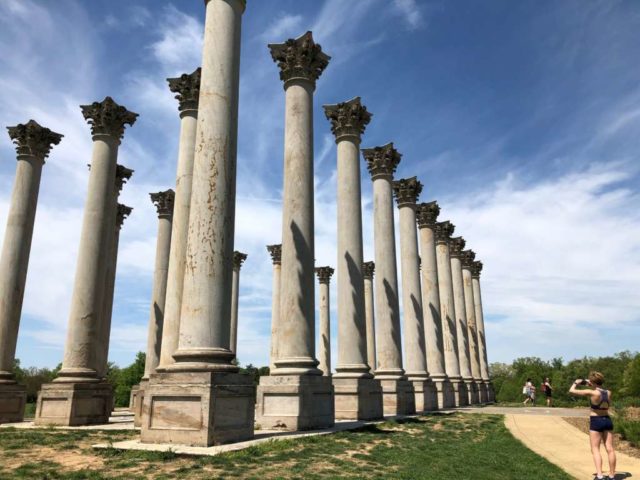
I don’t know what was wrong with me. I had this beautiful gift, and I had been ignoring it for years.
The last time I remembered running in the National Arboretum was right before Thanksgiving 2014. Then, for some reason, I just stopped running there. It wasn’t until the end of this past January, after months of me telling myself I should go back there, that I actually did.
What a treat.


